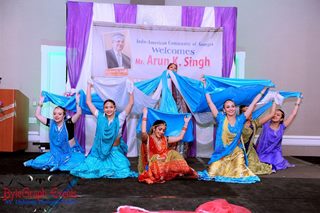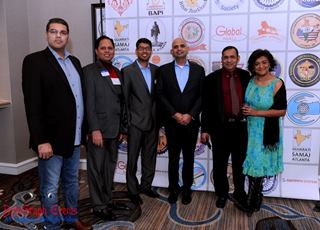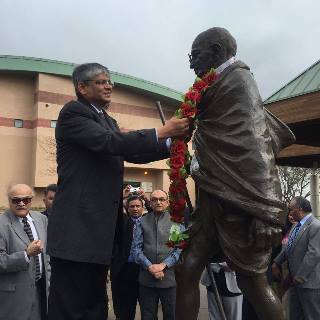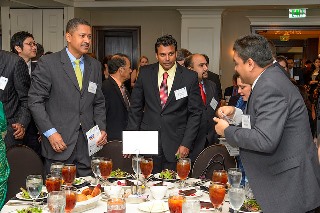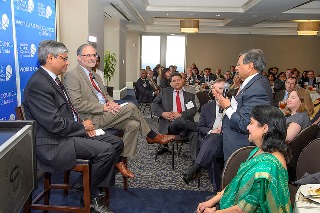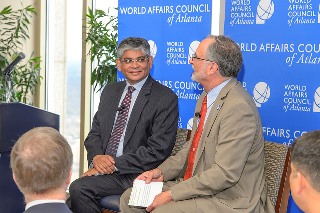Diplomacy: “Please Immediately Head for the Airport…”
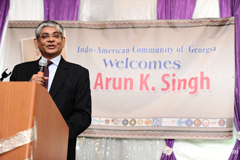
This lighthearted response from Arun Singh, India’s Ambassador to the USA, to a query about business and economic prospects in India, is nevertheless telling about his optimism and conviction.
A packed schedule awaited the Ambassador on his first visit to Atlanta in February to promote the growing economic ties between India and the USA. During his visit, he met with Georgia’s Governor Nathan Deal and Atlanta Mayor Kasim Reed, a host of business leaders and professionals, and visited the Mahatma Gandhi memorial at King Center. His meetings with Atlanta’s Indian-American community were sold-out events.
A common thread running through all of the Ambassador’s interactions was the projection of India as a young nation eager to embrace modernity and realize its huge economic potential.
Following are some highlights of the Ambassador’s views, culled from our interview with him, as well as from his wide-ranging talk and Q&A at the World Affairs Council of Atlanta.
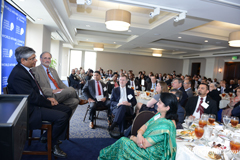
Atlanta rolled out a red carpet welcome for Indian Ambassador Arun Singh when he stopped by in February on a multi-city tour of the US to promote India as the hot, new destination for global investment. At all his speaking engagements, be it in meetings with local government officials and business heads or at Indian-American community get-togethers, the Ambassador emphasized the steadily deepening US-India partnership in multiple areas—trade, defense, joint military exercises, and collaboration in the high tech industry—a relationship that now seems less vulnerable than ever before to the shifting sands of national politics.
At the World Affairs Council of Atlanta (photo above), Ambassador Arun Singh addressed a packed audience of business leaders, entrepreneurs, and reporters among others. An accomplished diplomat and a savvy speaker, the Ambassador used the opportunity to project India’s ‘soft power’—its cultural complexity and democratic values—and fielded questions on a host of business related topics.
Foreign Policy
When queried on whether continued US-Pakistan
ties impacted the bilateral relations between India
and the US, the Ambassador offered a different
perspective: India’s relations with other nations are
built solely on national interest and maintaining
“strategic autonomy”: “…our attempt is to build good
relations with every major country in the world.
We have strong relationships with the US, we have
very strong partnerships in Europe. Germany is our
largest trading partner in Europe, we have a historical
and very strong diaspora-based partnership with the
United Kingdom; and we have a very strong strategic
partnership with France.
“And looking further away from there, with Russia again historically and even now, we have a very strong partnership. Japan is a very, very strong partner for us in East Asia. We are also building a relationship of cooperation with China. I mentioned that the US is our largest trading partner with a trade volume of $1.3 billion in goods and services. But if you only consider trading in goods, China is our largest trading partner. So we have some differences but despite that we are very gracefully growing our relationship to enhance the areas of cooperation and understanding.
“Keeping our national interest as most important, our effort is to build good, productive, cooperative relationships with every major country in the world….and that’s the basis on which we also work our relationship with the US.”
Invest in India
The primary purpose of the visit was to promote investment in India, and Ambassador Arun Singh responded in detail to a series of questions about the business climate in the country.
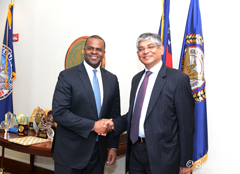
Anecdotes about India’s traditionally slow-footed bureaucracy, corruption, and red-tapeism are legion, but yearly rankings of nations in terms of ease of doing business show that the country is moving ahead, albeit with quite some way to go. Allaying worries on this score, the Ambassador remarked with a dash of humor, “I would advise Atlantans who want to do business in India to please immediately head for the airport, because already there is a huge presence of American companies in India. General Motors has just recently announced $2 billion investment, Ford has announced an additional $1 billion investment, we saw a Qualcomm announcement of about $150 million additional investment, KKR is bringing another $300 million. Now these are just a few examples.”
(Above) Atlanta Mayor Kasim Reed meets Ambassador of India, Arun Singh.
“As part of facilitating that process, the government has taken a whole series of steps to ease doing business. The number of approvals required has reduced, the processes have been simplified. Much of the process has now been made online so that there is transparency, and minimizes the face-to-face transactions. In many cases where a regulator’s approval was required, now we’ve allowed for self-certification. And we’re seeing impact [of these steps]. In the first six months of last year according to the survey reports, more FDI was committed to India than to any country in the world. So please be the first responders and seize the initiative now.”
While large business entities would obviously have the staying power and means to negotiate the pitfalls of setting up shop in a new country, how difficult would it be for small and medium industry to do business in India? Arun Singh was quick to point out that the steps he had highlighted were actually targeted towards facilitating SMEs (small and medium-sized enterprises). He added, “We have also revitalized an entity in India called Invest India which is a public-private partnership between the government and Federation of Indian Chambers of Commerce and Industry, and their job is to hand-hold the investor.”
India, said the Ambassador, is capital deficient, but has a surplus of skilled manpower—making it an ideal destination for R&D for major companies. GE, for example, has more than 6,000 people in India just doing R&D work. The company developed an ultrasound in India which was very, very cost effective, and now they are taking it to Africa and Latin America and other parts.
“We have a very young population: our median age is now 29 and the projection is, in the next 50-60 years the bulk of Indian population will be in the working age bracket. The young people in India don’t want to work for anybody else. They want to do their own initiative, enterprise. So, startups in India have picked up in a big way. In the last two years $6 billion have flowed into startups in India. I have found that US entities, venture capitalists, angel investors are all involved with the process starting in India and of course, the opportunity in India.”
Make in India and Skilling India—Challenges and Opportunities
For entrepreneurs looking to set up shop in India, quality in manufacturing is typically compared to that of China, and found wanting. That holds back manufacturers, even as they enthuse over Prime Minister Narendra Modi’s bold new Make in India initiative. Fielding a query on how foreign businessmen can support Make in India and still ensure quality,
the Ambassador explained, “Clearly it’s a very important and necessary program. Necessary because since the 1990s, with all the changes happening in India, unlike in most developing countries, we
went straight from agriculture to services, without expanding manufacturing in any significant way, perhaps reflecting some of the challenges and constraints in India that you spoke about.”
Another concern is that despite a huge population of young people, trade skills in India—carpentry, plumbing, electricians—are sorely lacking. When queried on this vis-à-vis the Indian government’s skills training initiatives and how foreign business can pitch in to upgrade skills, the Ambassador explained, “Today, more than 60 percent of our GDP is generated by the services sector. Services sector, in many areas, you can have very important value addition, but the employment generation will not be of the same level. I’ll give one example—the IT sector in India generates 7 percent of our GDP and employs about 3 million people. Agriculture generates 14 percent of our GDP and employs 700 million people.
“And in India as you know, with our current rate of growth of population, we create one Australia every year. So we have to create huge employment opportunities, we have to ease the pressure on agriculture, enable people to have alternative jobs and therefore there is no option but to expand manufacturing in India. To be able to do that, again we have no options but to expand infrastructure. And there is a huge emphasis by the government now on expanding infrastructure. Japan has just recently given us a loan of $15 billion over 50 years, no repayment for first 15 years, 0.5 percent rate of interest to build a high speed bullet train line between Mumbai and Ahmedabad. And that’s just one example. We are building a dedicated freight corridor between Delhi and Mumbai. So as we do this, and keeping in mind global and competitive requirements, clearly quality will continue to rise, there is no option but to do that. Again as a part of this process, skill will be important, because at one level higher education will be relevant but we have to train people and skill them for particular jobs. This government has in fact set up a whole new ministry of skill development and entrepreneurship and they are looking at partnerships with private sector with institutions that have capacity to work in this area.”
On specific areas where India welcomes investment:
“I would say we should focus on innovation and new technology and digital technology. Because the traditional areas of cooperation and partnership are going on and they will go on. But based on our strength, and what I see here, if we look at renewable energy, solar energy, if we look at digital technology, if we look at the whole space of innovation and R & D, those are the areas where we should build a new partnership.”
On transfer pricing or value added tax applied when goods reach Indian shores:
“This is a problem that not just India but all countries in the world are facing. Recently you would have
seen some European countries have imposed taxes
on US companies for similar reasons. But we are working on having advanced pricing agreements between
the government and the companies involved, so that they know in advance what the taxes will be. And in many of these cases we are involving an advance pricing agreement between the Indian government, the company, and the US government, so that the US government is also fully involved in the process, because they would also be liable to some US tax. So then everybody is on the same page. There are many such agreements that have already been worked out. And I think more and more will happen. So
with more experience and cooperation in working
and dealing with such situations, the position has eased considerably.”
On the process of selecting 100 Smart Cities:
Another new Indian government initiative that has aroused interest in overseas investors is the
‘100 Smart Cities’ program, aimed at creating world
class infrastructure in pockets of urban India. The Ambassador explained the rationale and working of the scheme succinctly: “We have selected about 100 smart cities in rural and secondary urban areas as the first step, because the government feels the need to relieve pressure from the bigger [metropolitan cities]. There was a transparent bidding process for the selection and justification of the initial 100 cities being strategically selected in the first round. Following which, there was a secondary selection process
for the first five of them to get funded from the central
government. As part of this process, the US has
been identified as a partner for three cities—and they are Visakhapatnam, Ajmer, and Allahabad. The U.S. Trade and Development Agency is working on making some funding available for an initial study relating
to conceptualization of schemes for such development within this partnership. Some US private sector
entities are also involved in the process.”
vvvvvvvvvvvvvvvvvvvvvvvvvvvvvvvvvvvvvv
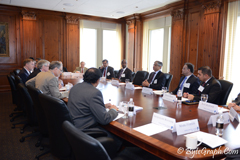
(Left) Ambassador Arun Singh at one of his various meetings with business and political leaders during his February Atlanta visit.
Signing off on an enthusiastic note about his Atlanta visit, Ambassador Singh said, “I have had extremely good meetings. I met the Governor, the Mayor, [had] a presentation at the World Affairs Council of Atlanta. ..great discussions, good turnout. Then yesterday, the business round table [and] the large number of Indian community organizations came together. This morning, I visited the CDC, which again is very important because we have cooperation with the CDC in areas related to disease control. They have a presence in India, we have a partnership with them. We have built up a global disease detection center, also in India. That’s an ongoing, very important area of cooperation. Then I visited Lockheed-Martin where they are building the C-130 aircraft for India. And as you know, some parts of the C-130, for their global supplies, are made in India and then brought here. It’s been an extremely productive visit and most of the things I would have liked to do on a first visit, I did. And I can see that there’s a huge interest here in the government in the business community and the people.”
Website Bonus Feature
Photo Gallery:
|
|
|
|
|
|
|
|
|
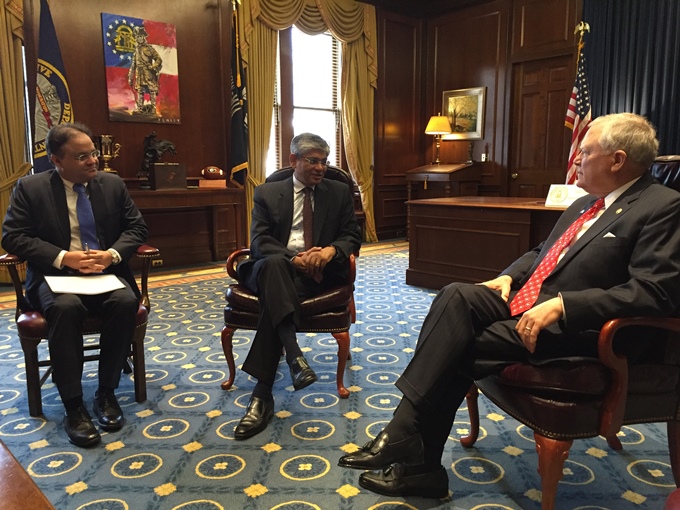
Enjoyed reading Khabar magazine? Subscribe to Khabar and get a full digital copy of this Indian-American community magazine.
blog comments powered by Disqus




